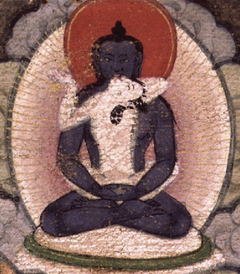Song of the Vajra
Schools & Systems › Dzogchen | Practices › Tsok | Literary Genres › Songs and Poems | Words of the Buddha | Tibetan Masters › Longchen Rabjam

Samantabhadra and consort
Courtesy of Himalayan Art Resources
Further information:
༄༅། །རྡོ་རྗེའི་གླུ། །
The Song of the Vajra
From Longchenpa’s Treasury of the Supreme Vehicle1
ཨེ་མ་ཀི་རི་ཀི་རི། མཥྚ་བཱ་ལི་བཱ་ལི། ས་མི་ཏཱ་སུ་རུ་སུ་རུ། ཀུ་ཏཱ་ལི་མ་སུ་མ་སུ། ཨི་ཀ་རཱ་སུ་ལི་བྷ་ཏ་ཡེ། ཙ་ཀི་ར་བྷུ་ལི་ས་ལ་ཡེ། ས་མུནྟ་ཙརྻ་སུ་གྷ་ཡཻ། བྷེ་ཏ་ས་ན་བྷ་ཀུ་ལི་ཡཻ། ས་ཀ་རི་དྷཱུ་ཀ་ན། མ་ཏ་རི་བཻ་ཏ་ན། བ་ར་ལི་ཧི་སཱ་ན། མ་ཁརྟ་ཀི་ལ་ནཱཾ། སཾ་བྷ་ར་ཏ་མེ་ཀ་ཙརྟཾ་པ། སུརྻ་བྷ་ཏ་ར་ཨེ་པ་ཤ་ན་ས། རན་བྷི་ཏི་ས་གྷུ་ར་ལཱ་ས། མ་སྨིན་པ་གུ་ལི་ཏ་ཡ་ས། འགུ་རཱ་འགུ་རཱ་སག་ཁ་ར་ན་ལཱི། ན་ར་ན་རཱ་ཨི་ཐ་ར་པ་ཊཱ་ལ། སིར་ཎཱ་སིར་ཎཱབྷེ་ས་ར་ས་པ་ལཾ། བྷུན་དྷ་བྷུན་དྷ་ཚིཥ་པ་ཀེ་ལཾ། ས་སཱ། རི་རཱི། ལི་ལཱི། ཨི་ཨཱི། མི་མཱི། ར་ར་རཱ།
ema kiri kiri | mashta bhali bhali | samita suru suru | kutali masu masu | ikara suli bhatayé | tsakira bhuli salayé | samunta tsaraya sughayé | bheta sana bhaku liyé | sakari dhukana | matari betana | barali hisana | makharta kilanam | sambhara tameka tsatampa | surya bhatara epashanasa | ren bhiti saghu ralasa | masminpa guli tayasa | ghura ghura sag kharanali | nara nara ithara patala | sirna sirna bhesa rasapalam | bhundha bhundha tshisha pakelam | sasah | ririh | lilih | i ih | mimih | ra ra rah |
ཞེས་ཉི་ཟླ་ཁ་སྦྱོར་ལས་བཤད་པ་ལྟར་ཆོས་ཉིད་ཀྱི་གླུ་ཀུན་བཟང་ཡབ་ཡུམ་གྱི་དགོངས་པ་བླངས་ཏེ།
As explained in the Tantra of the Union of the Sun and Moon, this dharmatā song evokes the wisdom of Samantabhadra in union. As for its meaning:2
མ་སྐྱེས་པས་ན་མི་འགག་ཅིང་། །
makyepé na mingak ching
Without birth and so without cease,
འགྲོ་དང་འོང་མེད་ཀུན་ཏུ་ཁྱབ། །
dro dang ongmé küntu khyab
Not coming or going, but filling all,
བདེ་ཆེན་ཆོས་མཆོག་མི་གཡོ་བ། །
dechen chö chok miyowa
Blissful dharma sublime and unmoving,
མཁའ་མཉམ་རྣམ་གྲོལ་གོས་པ་མེད། །
khanyam namdrol göpamé
Sky-like, freed and without stain,
རྩ་བ་མེད་ཅིང་རྟེན་མེད་ལ། །
tsawamé ching tenmé la
Rootless, and also without support,
གནས་མེད་ལེན་མེད་ཆོས་ཆེན་པོ། །
nemé lenmé chö chenpo
Homeless, unattached, a dharma profound,
ཡེ་གྲོལ་ལྷུན་མཉམ་ཡངས་པ་ཆེ། །
yedrol lhün nyam yangpa ché
Ever free, ever vast, equality effortless,
བཅིངས་མེད་རྣམ་པར་བཀྲོལ་མེད་པ། །
chingmé nampar trol mepa
Subject to neither bondage nor liberation,
ཁྱབ་གདལ་ཁང་བཟང་ཡེ་ཡོད་ཉིད། །
khyab dal khang zang yé yö nyi
An ever present palace encompassing all,
ཁྱབ་མཉམ་པ་ལས་རྣམ་འདས་པ། །
khyab nyampa lé nam depa
Beyond logic and reason.
ཡངས་སོ་ཆེའོ་ནམ་མཁའི་དབྱིངས། །
yang so che o namkhé ying
So vast, so grand, the space of the sky!
ཆོས་ཆེན་འབར་བ་ཉི་ཟླའི་དཀྱིལ། །
chö chen barwa nyidé kyil
Blazing dharma, the core of the sun and the moon,
ལྷུན་གྱིས་གྲུབ་དང་མངོན་སུམ་པ། །
lhün gyi drub dang ngönsum pa
Instant presence, now it’s so plain to see,
རྡོ་རྗེ་རི་བོ་པདྨ་ཆེ། །
dorjé riwo pema ché
A mountain of vajra, a lotus so immense
ཉི་མ་སེང་གེ་ཡེ་ཤེས་གླུ། །
nyima sengé yeshe lu
The sun, a lion, this wisdom song.
སྒྲ་ཆེན་རོལ་མོ་མཚུངས་པ་མེད། །
dra chen rolmo tsungpamé
A sound so great, a music beyond compare,
ནམ་མཁའི་མཐའ་ལ་ལོངས་སྤྱོད་པ། །
namkhé ta la longchö pa
A pleasure reaching to the ends of space,
སངས་རྒྱས་སངས་རྒྱས་ཀུན་མཉམ་ཞིང་། །
sangye sangye kün nyam zhing
A buddha equal to all of the buddhas,
ཀུན་བཟང་ཡངས་པ་ཆོས་ཀྱི་རྩེ། །
kunzang yangpa chö kyi tsé
Samantabhadra the vast, the peak of dharma,
མཁའ་དབྱིངས་བཟང་མོའི་དབྱིངས་རུམ་དུ། །
khaying zangmö ying rum du
In the womb of Samantabhadrī, her sky-like space,
ཀློང་གསལ་ལྷུན་གྲུབ་ཡེ་རྫོགས་ཆེ། །
longsal lhündrub yé dzok ché
Open clarity, instantly present—the ever great perfection!
ཅེས་པའི་དོན་ཏེ། སེམས་ཉིད་ཁྱབ་གདལ་ཡངས་པའི་ངང་ནས་བླང་ངོ་། །
Sing this while remaining within the all-pervasive expanse of mind’s nature.
| Samye Translations (trans. by Peter Woods and Stefan Mang), 2018.
Version: 1.2-20220729
- ↑ The following famous prayer has been extracted from Longchenpa’s explanation of Vajra Song and Dance (rdo rje’i glu gar) given in The Treasury of the Supreme Vehicle (theg mchog mdzod).
- ↑ As stated by Longchenpa, the original source of this mantra is The Tantra of the Union of the Sun and Moon (nyi zla kha sbyor), one of the Seventeen Tantras of the Category of Pith Instructions. Namkhai Norbu Rinpoche explains this mantra to be the naturally resonant mantra of the Buddha Samantabhadra in the form of a vajra song. Rinpoche stated that the song was not written in Sanskrit, but rather in the ḍākiṇῑ script of Uḍḍiyāna. Rinpoche points out that there are many different versions of this song. Rather than seeing one as correct and the others as incorrect, Rinpoche explained that they should all be considered as correct “because this teaching did not come from only one place or at only one time.” Following the mantra, Longchenpa added the following lines. For a general explanation of the importance of this mantra, see: Chögyal Namkhai Norbu, “The Song of the Vajra is the Very Essence,” in The Mirror 93 (July/August 2008), 2-3; for an explanation of the syllables of this mantra, see: Namkhai Norbu, The Dzogchen Ritual Practices, trans. Brian Beresford (London: Kailash Editions, 1991), 132-136; for its intonation, see: Ibid., 90-91.